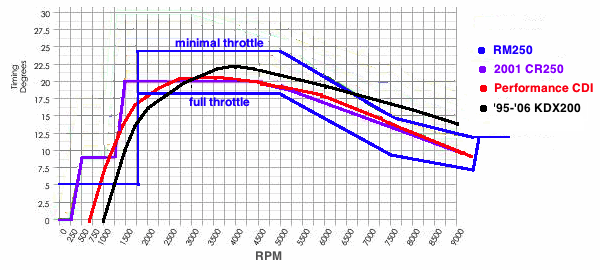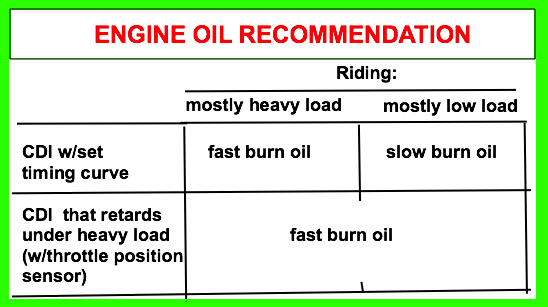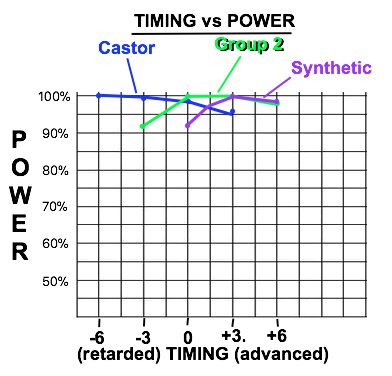|
I retested the two most extreme oil types, the fully synthetic and the castor containing oils. Each was tested for best timing for best speed on nearly flat road, slightly inclined road, and road with a fairly steep incline for my small engine which represents a "high load" situation because it caused a continual decrease of RPM down to about half speed (but I noted engine speed along a telephone pole where the speed had only decreased about 750 RPM). Note at the lower right section of the graph below the three zones of engine load. Notice that the fast burn oil (the one with castor) needed less timing advance at the "high load" zone. This agrees with my previous tests. Ignition timing curve My engine doesn't need timing retard because it never gets above 7000 RPM and it doesn't have a squish band in the cylinder head which would speed up the rate of combustion as RPM gets into the high RPM zone (thus needing some retard). High load can include hill climbs, mud and sand runs, and even heavy acceleration common to racers. Many racers have self adjusting ignition systems which retard timing during heavy load but many do not. Someone with a self adjusting CDI should only use fast burn engine oils. People with CDI's that don't retard the timing under high load should use slow burn engine oils.  Look at how this timing curve of a Suzuki RM250 adjusted the timing downward (more retarded) when the sensors indicated the rider was going thru a "high load" situation of WOT and less than peak RPM. I would guss that the fast burn oils match that CDI timing the best. Notice how almost all recommended oils for motocross bikes are "fast burn" semi-synthetics that have both group 1 mineral oil and synthetic oil (for example the Motorex oils that KTM recommends).  If you want to know what any popular engine oil has in it just look it up on my oils page and if it's not there then try to find its safety data sheet on-line and notice the CAS # of any oil in it and then look that # up on this page to know the oils group #. Engine oils with group 1 or castor are "fast burn", and "slow burn" oils are the full synthetics and the oils made of just group 2 oil. Here's my video on the subject: YouTube where you can comment what happened when you adjusted for oil type or what happened when you compared fast and slow burn oils on your ride with non-adjustable timing. Such feedback is needed for people to realize this area of fine tuning.  Retesting Oils March 30 2024 Science is based on observation and repeatability so I redid the tests. The different needed timings for different types oil remains unchallenged but I had drastically different head temps, so much so that I advise disregarding everything I said about oils affecting head temps (assuming the timing is right for the oil). All the temps were within a few degrees of each other. Of course there is still some measurement variability due to using an infrared thermometer and it all depends on how many seconds after letting off the gas it takes to measure the temp at the base of the spark plug. I really need a gauge with its thermocouple as a big copper washer between the head and the spark plug. I had one but its thermocouple broke. Here's todays graph of my uphill tests. The most timing independent oil is castor, next is group 2 oil, and last is synthetic. Notice 6 degrees difference between castor and synthetic.  |